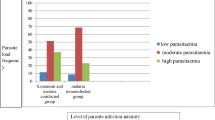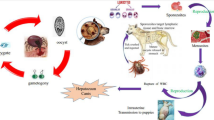Abstract
In the present study the kinetics of the uptake and deposition ofSchistosoma mansoni antigens in liver, spleen and kidney ofS. mansoni infected Swiss mice have been investigated in relation to duration of infection and infection dose (50, 100, 200 cercariae). The presence of antigen was studied with a direct immunofluorescence reaction on frozen sections of the organs, using a number of fluorescein isothiocyanate (FITC)-labeled antisera produced against various antigen preparations isolated from different life-cycle stages of the parasite. The presence of antigen was demonstrable with two of the antisera, directed against the circulating anodic antigen (CAA) and against total soluble egg antigen (SEA).
CAA was demonstrable from 1 week post infection (p.i.) onwards in Kupffer cells in the liver, from 2–3 weeks p.i. onwards in macrophages in the marginal zones in the spleen and from 3 weeks onwards in kidney glomeruli. Immunofluorescence reactions on CAA in kidney glomeruli, however, were only weak positive until 12 weeks p.i., whereafter strong positive reactions were found.
SEA was demonstrable from 5 weeks p.i. onwards in Kupffer cells in the liver and from 4 weeks p.i. onwards in macrophages of the spleen. In contrast to CAA, SEA was not detectable in kidney glomeruli.
Similar content being viewed by others
References
Andrade ZA, Sadigursky M (1978) Immunofluorescence studies of schistosome structures which share determinants with circulating schistosome antigens. Trans R Soc Trop Med Hyg 72:316–318
Berggren WL, Weller TH (1967) Immunoelectrophoretic demonstration of specific circulating antigen in animals infected withSchistosoma mansoni. Am J Trop Med Hyg 16:606–612
Bout D, Santoro F, Carlier Y, Bina JC, Capron A (1977) Circulating immune complexes in schistosomiasis. Immunology 33:17–21
Byram JE, Lichtenberg F von (1977) Altered schistosome granuloma formation in nude mice. Am J Trop Med Hyg 26:944–956
Deelder AM, Klappe HTM, Van den Aardweg GJMJ, Van Meerbeke EHEM (1976)Schistosoma mansoni: demonstration of two circulating antigens in infected hamsters. Exp Parasitol 40:189–197
Deelder AM, Van Dalen DP, Van Egmond JG (1978)Schistosoma mansoni: microfluorometric determination of circulating anodic antigen and antigen-antibody complexes in infected hamster serum. Exp Parasitol 44:216–224
Deelder AM, Kornelis D, Van Marck EAE, Eveleight PC, Van Egmond JG (1980)Schistosoma mansoni: characterization of two circulating polysaccharide antigens and the immunological response to these antigens in mouse, hamster, and human infections. Exp Parasitol 50:16–32
El-Dosoky I (1980) Histochemical and histopathological changes of spleen in experimental schistosomiasis and effect of therapy. Thesis, Mansoura Medical Faculty, Mansoura, Egypt
Ferreira AW, Caldini ALM, Hoshino-Shimizu S, Camargo ME (1979) Immuno-enzymatic assay for the detection ofSchistosoma mansoni antigens in serum of mice harbouring bisexual and unisexual light worm infections. J Helminthol 53:189–194
Hoshino-Shimizu S, De Brito T, Kanamura H, Canto AL, Silva AO, Campos AR, Penna DO, Da Silva LC (1976) Human schistosomiasis:Schistosoma antigen detection in renal glomeruli. Trans R Soc Trop Med Hyg 70:492–496
Magalhaes Filho A, Krupp IM, Malek EA (1965) Localization of antigens and presence of antibody in tissues of mice infected withSchistosoma mansoni as indirect immunofluorescent antibody technique. Am J Trop Med Hyg 14:84–99
Nash TE, Prescott B, Neva FA (1974) The characteristics of a circulating antigen in schistosomiasis. J Immunol 112:1500–1507
Rotmans JP (1978)Schistosoma mansoni: antigenic characterization of malate dehydrogenase isoenzymes and use in the defined antigen substrate spheres (DASS) system. Exp Parasitol 46:49–58
Steinbuch M, Audran R (1969) The isolation of IgG from mammalian sera with the aid of caprylic acid. Arch Biochem Biophys 134:279–281
The TH, Feltkamp TEW (1970) Conjugation of fluorescein isothiocyanate to antibodies. I. Experiments on the conditions of conjugation. II. A reproducible method. Immunology 18:865–873, 875–881
Van Marck EAE (1975) Presence of the circulating polysaccharide antigen in the liver of mice infected withSchistosoma mansoni. Ann Soc Belg Med Trop 55:373–377
Van Marck EAE, Deelder AM, Gigase PLJ (1977) Effect of partial portal vein ligation on immune glomerular deposits inSchistosoma mansoni infected mice. Br J Exp Pathol 58:412–417
Van Marck EAE, Deelder AM, Gigase PLJ (1981)Schistosoma mansoni: Anodic polysaccharide antigen in glomerular immune deposits of mice with unisexual infection. Exp Parasitol 52:62–68
Author information
Authors and Affiliations
Rights and permissions
About this article
Cite this article
El-Dosoky, I., Van Marck, E.A.E. & Deelder, A.M. Presence ofSchistosoma mansoni antigens in liver, spleen and kidney of infected mice: a sequential study. Z. Parasitenkd. 70, 491–497 (1984). https://doi.org/10.1007/BF00926690
Accepted:
Issue Date:
DOI: https://doi.org/10.1007/BF00926690




